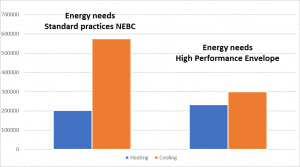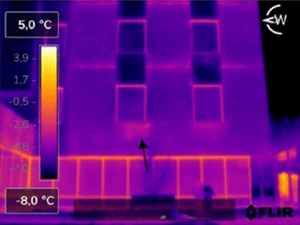- July 7, 2023
The benefits of designing from the outside in
With a national goalpost set for carbon neutrality by 2050, we’ve already begun to see cities mobilize with ambitious plans to see meaningful and sustainable change by 2030. In Montreal alone, the city seeks a 55% reduction in greenhouse gases (GHG) between now and 2030; among strategies like regreening urban areas and transportation electrification, one of the key steps in its momentum lies in new sustainable buildings having “zero-emission” standards by 2025.
Recognized as one of the greatest contributors to global emissions, the new buildings represent around 40% of energy related CO2 emissions. What we build and how we build them can fill a major gap in our pathway to carbon neutrality. They need, however, to achieve two goals: They must have a zero or negative carbon footprint in terms of direct and indirect emissions from low energy consumption and the embodied carbon of their materials. One can’t happen without the other to be truly effective.
Renewable energy sources and new technologies play an important role in achieving these objectives, but by paying particular attention to the envelope and optimizing a building’s thermal performance, a bottom-up, passive design approach can be taken which helps improve energy efficiency further.
Optimizing for impacts
In 2020, Lemay joined a study carried out by Martin Roy et Associés to identify the best strategies to achieve Montreal’s decarbonization objectives. The findings showed that from home and multi-unit buildings to offices, commercial structures, and storage facilities, the result was the same: Energy performance of buildings can be greatly improved through optimized envelopes, using proven simulation and evaluation methods.
“Even if heating and energy performance were optimized, they could be architecturally enhanced with a high-performance envelope,” says Oscar Hernandez, Lemay’s Technical Director in Building Performance and Sustainable Strategies.
The current strategy when constructing new buildings is to take aim at reducing heating-related energy consumption. This, however, raises a new issue during summer seasons. As air conditioning systems are installed to compensate for higher temperatures, energy-efficient buildings consume more resources and energy to ensure thermal comfort. This increases building energy needs in summer to minimize consumption in winter, and it’s a prime example of why envelope performance is crucial to providing a good balance.

Source: Lemay Sustainable Department – Building energy needs without taking heating and air conditioning systems into account.
“It’s not something we consider often enough, but it’s comparatively easy to do and it could improve a lot of performance issues within buildings. The amount of energy and resources necessary for the coming energy transition are rising exponentially, so we need to reduce our resource consumption while improving energy performance” Oscar explains.
Projects like the upcoming zero-carbon residential building 485 Albert in Kingston, Ontario demonstrate how big of an impact a high-performance enclosure can make alongside low-impact construction materials and energy efficiency heating and cooling sources. But better still, these kinds of strategies are not restricted to new constructions: The Montreal head office for UAP, for example, shows how a pre-existing structure can reduce its overall energy consumption by as much as 34% by making envelope optimization part of its sustainable strategies.
“We tend to focus on the performance of systems—heat pumps, ventilation, air conditioning—and while these are important, we’re beginning to see that the envelope, fenestration, and airtightness of buildings plays an incredible role in our needs. If we want to reduce our carbon emissions, we need to think about how to reduce energy needs, not just energy consumption.”
While technological advancements in systems are part of moving forward to carbon neutrality, the greater a building’s systems’ power and resilience, the more they require heavy investments in installation and maintenance by specialists. In short, if we want to prepare buildings for the next 20 years, the reality is that complex mechanical systems require complex solutions, whereas envelopes are far less intensive by comparison.
Thoughtful designs for peak performance
“Of all the energy efficiency measures studied, reducing air infiltration through exterior elements is the only main factor that generates substantial, recurring savings,” Martin Roy et Associés summarized in the report.

A thermographic analysis showing heat loss from the envelope; air and heat leaks like this can reduce energy performance and be a source of discomfort. (Source: Thermographic analysis of residential buildings built according to the National Energy Code of Canada for Buildings, 2011)
If we look at a building that only prioritizes energy efficient systems, there will be significant savings and increased performance, but by making high-performance envelope part of that equation, the results are significantly improved—and it will be far easier to operate and maintain.
“Combining an optimized thermal envelope with basic mechanical equipment such as an electric boiler can offer remarkable efficiency. When we look at geothermal systems like heat pumps or other geothermal systems in comparison—which can be difficult to optimize and maintain—the high-efficiency envelope proves more efficient, with lower investment and better quality.”
Not only do these envelope-focused design approaches for thermal comfort address issues of optimization and maintenance, but also scarcity: According to the International Energy Agency (IEA), the demand for heat pumps by 2050 will be so high that it brings about issues of meeting demand due to scarcity of resources.
“It’s not that we need to avoid digitalization and technology,” Hernandez adds. “We need that, but when designing for efficiency, we need to be only using the systems we need.”
Revisiting the drafting table
With an envelope-first approach, we have a new mandate with which buildings can be designed. Much like a passive building strategy, the wealth of shapes that buildings can take can be better modified to account for not only its energy efficiency and emissions, but the health and well-being of its users as well.
As we design the futures for cities city that rely on renewable energy, the viability of those energy sources could be even more possible through making these kinds of architectural augmentations.
There’s a great learning curve ahead of us if we want to build smart, zero-carbon buildings that meet the world’s demands. Trial and error is expected as we arrive at the best possible envelopes for energy efficiency and emissions, but above all, ensuring that architecture and building operation work in symbiosis from the outset is a key to success.
Learn more about the intersections of sustainability and transdisciplinary architectural design with our NET POSITIVE™ strategies for benefits to user health, the environment, and carbon emission reduction.